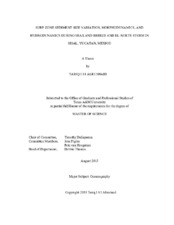| dc.contributor.advisor | Dellapenna, Timothy | |
| dc.creator | Alrushaid, Tariq I S I | |
| dc.date.accessioned | 2019-01-18T19:18:49Z | |
| dc.date.available | 2019-01-18T19:18:49Z | |
| dc.date.created | 2015-08 | |
| dc.date.issued | 2015-08-06 | |
| dc.date.submitted | August 2015 | |
| dc.identifier.uri | https://hdl.handle.net/1969.1/174191 | |
| dc.description.abstract | This study compares the effects of a mesoscale pressure system (i.e., cold front: referred to as El-Norte) and local pressure systems (land and sea breezes) on the hydrodynamics, beach profile, and particle size distribution of sediments within the surf zone. The effect of onshore and offshore wind has been investigated using measurements of hydrodynamics (water elevation, current velocities and direction), geomorphology (surface sediment samples and beach profiles), and meteorological observations (wind, temperature and atmospheric pressure). The experiment was conducted on Sisal beach located in the Gulf of Mexico along the northern coast of the Yucatan Peninsula from March 27th 2014 to April 11th 2014. For a 50 m cross section of the beach (i.e., the surf zone) hydrodynamics were analyzed by estimating turbulent kinetic energy, kinetic energy dissipation rate and bed shear stress using the measurements obtained from Acoustic Doppler Velocimeters (ADV). Significant wave height and wave period in the surf zone were computed using pressure sensors from ADVs. A pressure transducer located in the swash zone provided additional water free-surface elevation data to help assess wave energy dissipation.
During sea breeze cycles with wind velocities reaching up to 15 ms-1, rapid changes in wave height over a short period of time were observed. One El-Norte storm event affected the study site during the field campaign with maximum wind speeds of 15 ms-1, and significant wave heights of 1.5 m and 0.3 m in water depths of 10 m and 0.4 m, respectively. This study will test five hypotheses: (1) El-Norte is more effective in skewing sediment size distributions toward coarser grain sizes compared to regular sea-breeze events, (2) sea-breeze events result in deposition of sediment within the surf zone and erosion in the swash zone, in addition to onshore sandbar migration, (3) an individual El-Norte event can cause significant alterations to the beach profile resulting in a steeper beach profile and significant erosion in the swash zone and surf zone, (4) the undertow currents are stronger during El-Norte than during sea/land-breezes and play an important role in the offshore sandbars migration. | en |
| dc.format.mimetype | application/pdf | |
| dc.language.iso | en | |
| dc.subject | El-Norte | en |
| dc.subject | Sea-breeze | en |
| dc.subject | Land-breeze | en |
| dc.subject | sediments | en |
| dc.subject | Grain size | en |
| dc.subject | water elevation | en |
| dc.subject | current velocities and direction | en |
| dc.subject | wind | en |
| dc.subject | temperature and atmospheric pressure | en |
| dc.subject | turbulent kinetic energy | en |
| dc.subject | kinetic energy dissipation rate and bed shear stress | en |
| dc.subject | geomorphology | en |
| dc.subject | Morphodynamics | en |
| dc.subject | hydrodynamics | en |
| dc.title | Surf Zone Sediment Size Variation, Morphodynamics, and Hydrodynamics during Sea/Land Breeze and El-Norte Storm in Sisal, Yucatan, Mexico | en |
| dc.type | Thesis | en |
| thesis.degree.department | Oceanography | en |
| thesis.degree.discipline | Oceanography | en |
| thesis.degree.grantor | Texas A & M University | en |
| thesis.degree.name | Master of Science | en |
| thesis.degree.level | Masters | en |
| dc.contributor.committeeMember | Figlus, Jens | |
| dc.contributor.committeeMember | van Hengstum, Pete | |
| dc.type.material | text | en |
| dc.date.updated | 2019-01-18T19:18:50Z | |
| local.etdauthor.orcid | 0000-0001-7277-3094 | |


